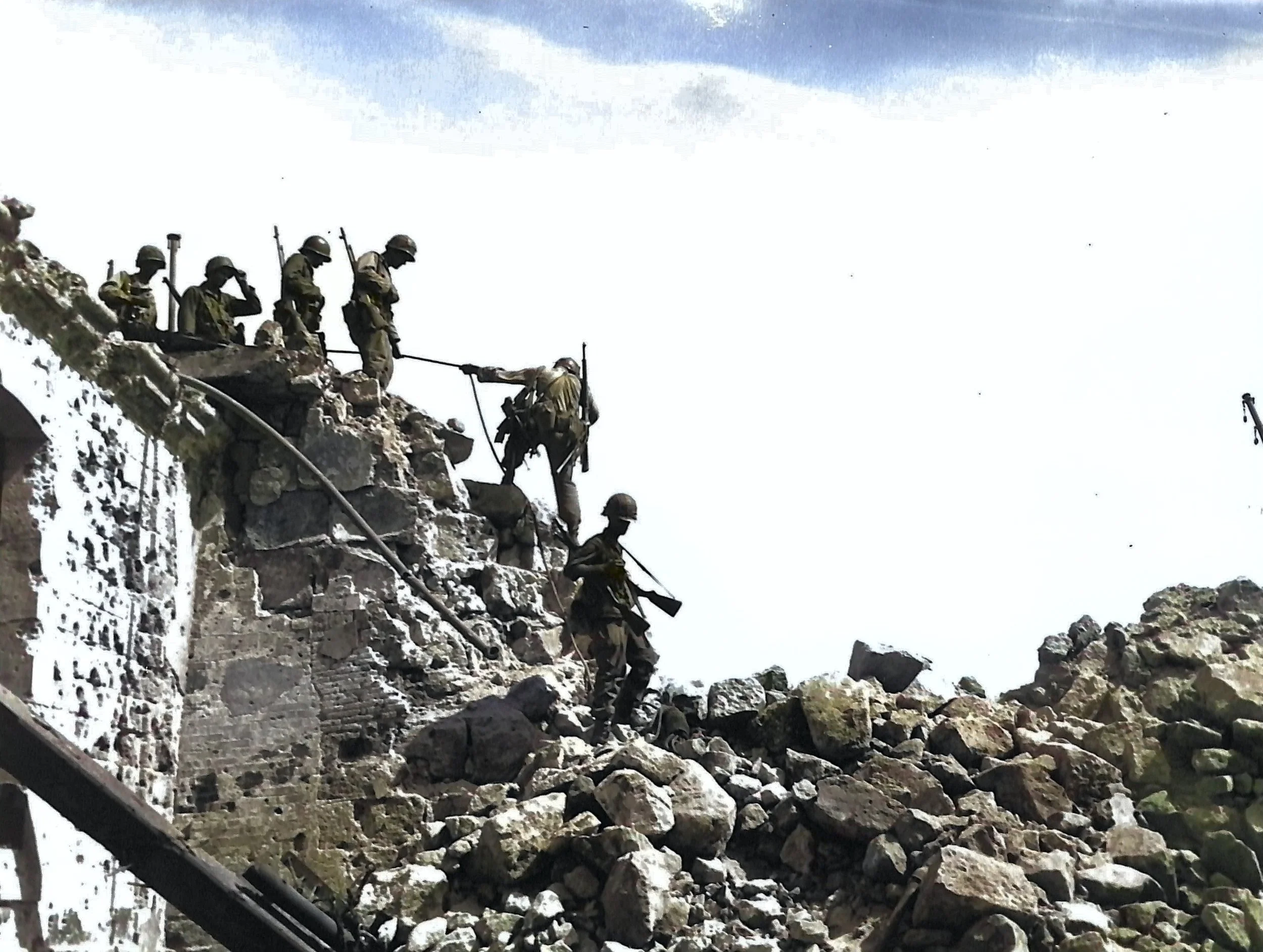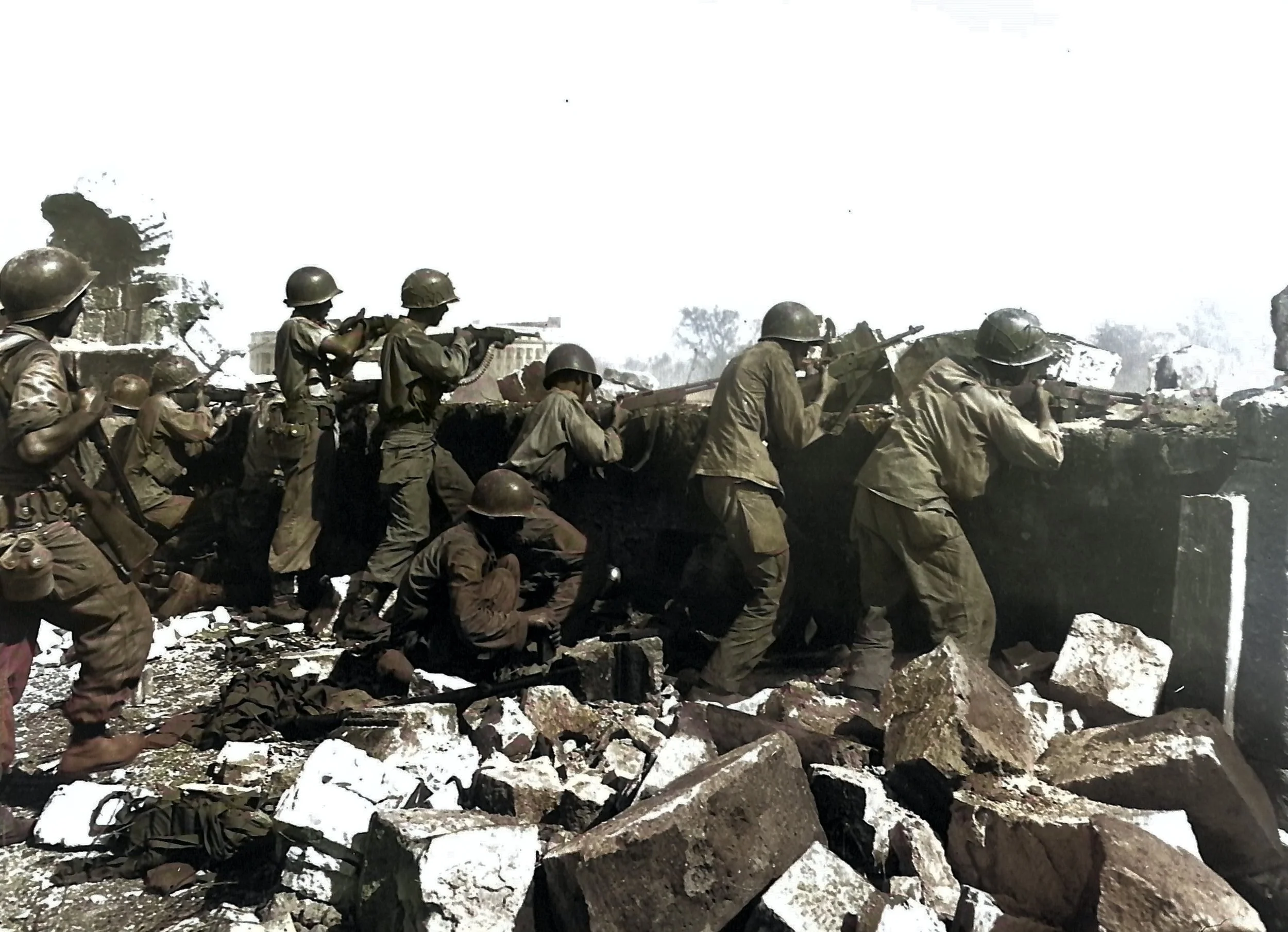Saturday, 24 February
The Intramuros and Port Fall
Looking over the Pasig at the wreck of Letran College and the Intramuros
US National Archives
Today the fighting for the Intramuros continued, as the Americans pushed into the pocket of Japanese resistance still extant in the southern side of the district. The Japanese continued to be driven back toward the aquarium, which was situated in one of the southernmost bastions of the fortress, along the west side of General Luna Street as it entered the Walled City. The Japanese had otherwise been mostly eliminated within the Intramuros, although occasional holdouts still fired on civilians and GIs roaming the blasted ruins that lined the rubble choked streets.
An M7 Priest self-propelled gun fires directly at targets within the Intramuros
US National Archives
The Japanese hold in the south was broken as American tanks entered Intramuros via the Santa Lucia Gate on the western wall, breaking off from the 1st Cavalry’s drive through the port. The aquarium was subjected to an attack by assault guns in a direct fire role, and the pummeling of the old stone fortification would drag on for hours, the Japanese inside supported by their comrades in the government buildings just outside the outer walls. US Infantry were finally able to enter the bastion after the discovery of an underground tunnel lining the outer wall to the inside, and cleared it of 115 MNDF troops before declaring it secure by 1430. Sweeps of the ruins of the district would continue for some time before the entirety of the district was declared secure at 1800. Of an estimated 2,000 Japanese troops defending the Intramuros, only 25 were captured alive, although a handful may have retreated to the government district to the south.
Americans clamber down the rubble of the Intramuros wall near the Aquarium
US National Archives
The 1st Cavalry also continued their push through the port district today. The battle over the Customs House had continued overnight, but just after noon the building was secured, and the troopers pushed northward, crushing the Japanese against the bay and the Pasig as they advanced. Just before 1700 the port district is declared secure, the last defenders, a mix of Chinese and Korean forced laborers, surrendering once their Japanese slave drivers were eliminated. Other elements of the cavalry were still fighting furious resistance as they blocked the Japanese in the government buildings of Luneta from moving to support the defense of the Intramuros or the Port.
GIs fire on the Japanese from the ramparts of Intramuros
US National Archives
The refugees of the battle and Japanese brutality continued to swarm over the Pasig, as the American hospitals and field kitchens worked at capacity to keep up. Still, some elements of normalcy were already returning north of the river. The Americans had managed to restore limited electrical and water supply to some areas and movies were screened in the yard of the University of Santo Tomas, along with concerts by local and Army bands. The suffering of the people of Manila was far from over, and the battle itself still had not drawn to a close, but one can only imagine what these small steps would have felt like for those who have escaped the maelstrom that has raged for weeks now.
The 37th Infantry Division Band performs a concert for civilians and former internees at Santo Tomas
US National Archives
As for the fighting on Corregidor, the Americans began their drive to clear the eastern tail of the island today, encountering pockets of fierce resistance but pushing the Japanese back. An attempted counterattack by the defenders resulted in 300 Japanese killed by American artillery and sniper fire as they tried to assemble, and the remainder pushed further back. By the end of the day the day the Japanese were in control over only the easternmost 3,000 yards of the island.
US troops move up behind a sherman on Corregidor
US National Archives
With the fall of the Intramuros and the Port, the Japanese were corralled into the government buildings of Luneta, and now would begin their final stand in the Legislature, Agriculture and Finance Buildings. The Americans in turn moved all their heavy artillery into position, and before the day was out a bombardment of these government buildings began the closing moves of the Battle of Manila.
Manila: 24 February, 1945
Legislature Building - Japanese strongpoint
Finance Department Building - Japanese Strongpoint
Agriculture Building - Japanese strongpoint and new headquarters of Admiral Iwabuchi
Port - The last remnants of the Japanese forces here mostly Korean conscripts, surrender in the afternoon






